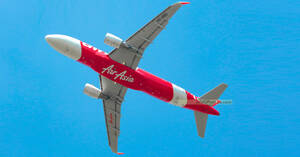 We are now on Telegram. Click to join We are now on Telegram. Click to join |
 We are now on WhatsApp Channel. Click to join We are now on WhatsApp Channel. Click to join |
Capturing the mysterious beauty of celestial bodies is now within grasp with the launch of the new D810A, a Nikon DSLR*1 designed with an array of features built specifically for the most dedicated astrophotography hobbyists.

Often requiring custom equipment and hours of persistence, stunning images of the night sky are within reach with the D810A, a pinnacle of bespoke imaging technology.
Chief among the D810A’s strength is its ability to capture astronomical subjects that emit the H-alpha wavelengths of light such as nebulae and other distant galaxies in red, allowing astrophotographers to see them just as imagined.
Helping even the most skilled photographers, are features such as longer exposures in low-light conditions with minimal noise, and a live view preview function which assists with planning the best shots. In addition, 36.3 megapixels ensure superior image quality in ultra-high definition.
Click on a link to jump to a specific section
- Stellar core for exceptional image quality
- Seeing red in high definition Spectacular captures of H-alpha wavelength nebulae
- A galaxy of features optimised for astrophotography
- Front-row seats to the greatest show on earth
- A Capable Companion
- Availability
1. Stellar core for exceptional image quality
Class-leading performance: The D810A is equipped with an array of top-notch features, designed to deliver superior image quality. At the core of full FX performance, images with rich tonality and high resolution are guaranteed with the 36.3- megapixel Nikon FX-format CMOS sensor built without an optical low- pass filter.
With the power of super- high resolution, the possibilities are endless as photographers can capture rich detail, crop with confidence or even turn photos into wallscapes. Taking things up a notch, the image sensor which has been specially-developed for the art of astrophotography, is particularly sensitive to emissions of the H-alpha wavelength, allowing astrophotography enthusiasts to shoot stunning images of nebulae and constellations.
Surpassing details and precise tonality: Also ensuring unrivalled image quality is the EXPEED 4 image- processing engine, which improves noise reduction performance at high sensitivities, as well as upgraded depth and clarity in gradation rendering. Made for capturing the night sky, the ISO sensitivity ranges from ISO 200 to 12800 and can be decreased to Lo 1 (ISO 100 equivalent), or increased up to Hi 2 (ISO 51200 equivalent) to suit a variety of environments.
2. Seeing red in high definition Spectacular captures of H-alpha wavelength nebulae
Behind the most powerful, readily available camera for astrophotography, is its unique ability to capture nebulae that emit the H-alpha wavelength in red, which cannot be achieved with ordinary DSLRs. The D810A*1 employs an optical filter (IR cut filter) with reassessed transmission characteristics in which the transmission of H-alpha spectral line has been increased by approximately four times from a typical DSLR.
This allows remarkably-detailed shots of nebulae, constellations and other celestial objects in rich tones and vibrant colours that are true to the eye with a high signal-to-noise ratio.
With more accurate and detailed colour reproduction, users can better understand the images that they take, and reduce the need for long hours of post-processing.
3. A galaxy of features optimised for astrophotography
Optimal settings with minimal configuration: With the special long exposure Manual (M*) mode, shutter speed can be set up to 900 seconds, making the D810A a light capturing powerhouse, able to shoot in the darkest of conditions. Be it the Milky Way or a meteor shower, users will find it a breeze to shoot in low-light conditions.
Vivid clarity for a masterpiece: One of the challenges astrophotographers face when they point their cameras to the sky, is the difficulty in observing the live view image which is often too dark, especially when photographing in the wilderness away from light pollution. The D810A offers an intelligent solution to this with the live view preview function which displays a brighter, clearer preview image when the shutter speed is set at 30 seconds or more*2, enabling easier focusing and framing adjustment, while minimizing misaligned focus on the desired subject.
Framed for perfection: Take a closer look at the stars and frame the perfect shot with the ability to enlarge live view images up to approximately 23 times. This helps astrophotographers achieve perfect framing and precise focusing, while retaining high definition in the LCD display.
4. Front-row seats to the greatest show on earth
Striking details with minimised distortion: The D810A is especially adept at capturing crisp, clear images of the moon’s surface or landscape photos with minimal blur, when using telephoto lenses. An electronic front-curtain shutter can be enabled to reduce internal mechanical vibration, by eliminating the movement of the conventional front curtain of a mechanical shutter. Vibration from mirror movement is also reduced with mirror-up shooting, increasing image clarity.
Uninterrupted inspiration: Smooth continuous shooting has never been easier, with the ability to take an unlimited number of high-quality JPEG images, a feature that is particularly handy when capturing beautiful light trails across the night sky. When using the CH or CL release mode with a shutter speed 4 seconds or longer, the duration of continuous shooting can be extended indefinitely, as long as memory card capacity and battery status permit.
Astrophotographers can also capture astronomical phenomena in action with cinematic quality, time-lapse video.
5. A Capable Companion
Built for journeys: Venturing out to photograph the unknown, the premium design and build of the D810A ensures that astrophotographers have reliable equipment that helps them capture their best shot, even in less than favourable weather conditions. Inheriting the robust, weather-resistant design from the Nikon D810, this FX-format DSLR offers a comprehensive seal against dust and water droplets, with a grip that sits comfortably in the hand for steady shooting.
For improved product endurance, various components have been repeatedly tested, such as a newly-designed, highly accurate and durable shutter, tested for 200,000 cycles with the unit actually loaded on the camera. This in turn provides photographers with reliability and years of trouble-free image capture.
Creative support: A variety of accessories to support the enthusiasm for the craft is also available, making astrophotography easier and more enjoyable. From a remote cord for remote shutter release, battery pack for longer battery life and uninterrupted captures, to a GPS unit which enables the recording of latitude, longitude, altitude, and Coordinated Universal Time (UTC) where photos were taken, these equipment are ready to assist an astrophotographer’s exploration of the galaxy. The new Picture Control system is also supported by the D810A and users can utilize the free Capture NX-D software application to process and adjust RAW images for full-scale photofinishing.
[1] The D810A is a digital SLR camera designed exclusively for astrophotography. When shooting under light sources with a significant amount of near-infrared wavelengths, or capturing common subjects exhibiting high reflectance at near-infrared wavelengths, resulting images may exhibit an unusually red cast.
[2] When Bulb or Time is set at M mode or M* mode, or when the shutter speed is set at 60, 120, 180, 240, 300, 600 or 900 seconds at M* mode
Availability
The Nikon D810A will be available in early June 2015.









Leave a Reply